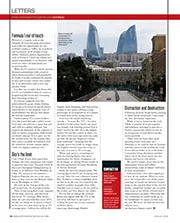

Letters, August 2016
Formula 1 out of touch Whenever a tragedy such as the Orlando, Florida shooting takes place, it provides the opportunity for any civilised country to reflect on its policies and…
What is more frustrating in a road car: too much performance or not enough? The answer seems simple enough: too much performance provides the option not to use it all, while not enough is simply not enough. But actually I demur. Increasingly I find far more irritating knowing a car has a level of power and performance I cannot safely access in public.
There are a few reasons for this. First, point to point speed is an overrated talent for a car to have. Point to point also means traffic to traffic, and the faster you go the less time you’ll spend with the road to yourself. Second, knowing your car can go so much faster than conditions allow is akin to cracking open a bottle of Pétrus and only being allowed to sniff its contents. Third, there is a whole world of fun to be had at a car’s performance limit and if you can’t reach it, you can’t enjoy it. Finally, and in its own way most compelling, is that there is no such thing as not enough performance. Some of the most memorable drives I’ve ever had came courtesy of my 1950s Citroen 2CV whose 425cc engine can muster 12bhp on a good day. Chris Harris, who owns a similar car, feels exactly the same.
So what’s the practical limit, before you need to start booking race tracks? Well, within the last month I spent a day in a couple of 500bhp Porsche GT cars and at exactly the right moment in exactly the right conditions on precisely the right road you could, very briefly, let them loose. At no stage did I ever think, “I wish I had another couple of hundred horsepower under my hoof.” Indeed, the idea was laughable. Beyond that, and at least in public, it’s a waste of time, money and power.
It’s very rare that a new class of car is created. With class barriers being melted by design-fluid crossovers, you’d think all the gaps would have been filled long ago. Except, of course, for the one right at the top. There have always been traditional flagship supercars, like the Ferrari 812 Superfast and Lamborghini Aventador, but then came additional layers. First there were the hypercars, like the McLaren P1, LaFerrari and Porsche 918. Fair enough. But not enough it seemed. Because next we got the hyper-hypercars, like the Aston Martin Valkyrie and Mercedes-AMG Project One. And there, surely, it would stop. Surely not. Because now there’s an entire new category of cars you can neither race nor use on the road, all competing to see which can rip your head off fastest in a quick corner.
“Something we don’t dwell on is that g forces aren’t much fun”
It started with the AMR Pro version of the Valkyrie, then Red Bull announced its Adrian Newey-designed RB17. More recently we received full details of the Rodin FZero and now there’s the McLaren Solus GT, whose single seat is accessed through your own fighter jet style canopy.
Now consider my contention a few column inches ago that there can indeed be such a thing as too much performance for a road car. I think the truth that would probably rather not speak its name with these cars – what shall we call them? Ultra-cars? – is that the same is going to be true on a track. At least for the majority of people who will own them. Because unless you’re not just a highly accomplished racing driver, but one very used to, as a minimum, modern prototype levels of downforce, you’re not going to be able to get close to what these cars can do. And, I further contend, you probably won’t want to either.
Something else that those who like to be associated with very fast cars don’t dwell upon too much in public is that extreme g forces aren’t much fun. If they were, people would do emergency stops for a laugh, because that way anyone in almost any car can experience a force equal to that of gravity coming at you from an unusual direction. But they don’t. It’s no more fun under acceleration, which is why the way fast electric cars deliver their performance is often so hateful, and even less so when coming from the side.
But these cars won’t just give you a mere single g of lateral acceleration, but possibly three or four. I have experienced more than 2g in racing cars and can’t say I found much at all to enjoy in being slammed into the side of my seat at a force twice my own body weight. True, many people ‘enjoy’ forces of up to around 4g on rollercoasters, but they are momentary, on a ride that lasts a very short time and depend on shock value for their popularity. Corner after corner, lap after lap the novelty wears off quite soon. But probably not as quickly as the muscles in your neck wear out. Which means you’ll need more than mere talent and courage to drive these cars to the limit, but a fitness regime designed to adapt your body to the task too.
Me? I’m curious to drive them, and if the time comes will do so as fast as I am able; but I am under no illusions whatever about my ability to reach their limits. I won’t be able to, as simple as that, and if you read any other common or garden hack suggesting that they can or have, you can safely disregard whatever they write next.
Loving all the banter surrounding Audi’s announcement that it’s joining the F1 grid in 2026, mostly involving the word ‘understeer’. I guess it is to shoot down the reputation that Audi doesn’t really make cars for drivers that lies in part behind the decision to get involved.
A former editor of Motor Sport, Andrew splits his time between testing the latest road cars and racing (mostly) historic machinery
Follow Andrew on Twitter @Andrew_Frankel